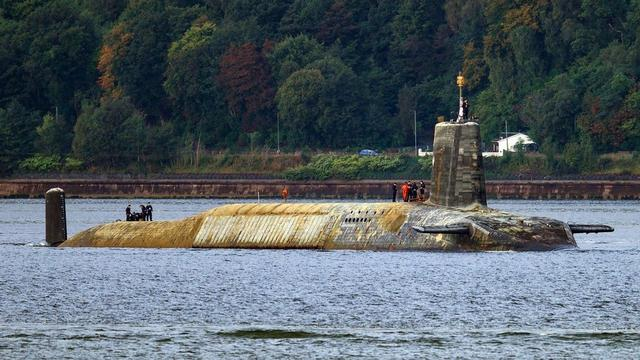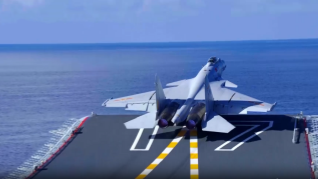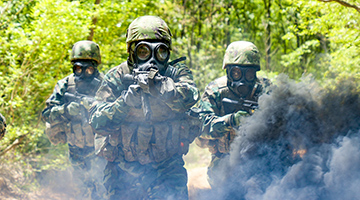
A Vanguard-class submarine returning from patrol
According to media reports, a Royal Navy nuclear submarine carrying 140 crew members and several UGM-133 Trident II (Trident D5) missiles broke down on mission in the Atlantic Ocean recently, causing an unplanned descent to dangerous depths zone narrowly avoiding shipwreck and casualties. The incident has again reignited the debate on the diminishing nuclear power of the country.
For many years, the Vanguard-class nuclear submarines have been a weapon that keeps the Royal Navy on edge. For example, in 2009, the HMS Vanguard submarine of the Royal Navy and Le Triomphant of the French Navy collided in the Atlantic Ocean, and the former was towed back to a port after the incident.
In 2015, Able Seaman William McNeilly, who was serving in the Royal Navy Submarine Service, published a self-composed report online saying that one only needs a fake identification document to board the nuclear submarine and access to the nuclear weapons system critical to national survival, and his service had at least witnessed more than 30 security vulnerabilities of the Vanguard-class submarine, including incomplete protection on classified information, incorrect computerized fire danger assessment, missiles early warning failure and void security check.
Later in June 2016, a Trident D5 missile launched from a Vanguard-class nuclear submarine sailing along the coast of Florida deviated from course, heading for the US continent instead of the west coast of Africa as planned, with no nuclear warhead installed fortunately. In November 2022, the Vanguard-class nuclear submarine HMS Victorious experienced an electrical fire accident during an underwater cruise in the Atlantic Ocean, when more than 130 sailors onboard had to immediately assist in extinguishing the fire and ascending the nuclear submarine to expel toxic gases.
Some analysts pointed out that the unrelenting troubles of the Vanguard-class submarines were mainly arisen from their extended service.
As the global strategic situation significantly changed after the end of the Cold War, the UK adjusted its nuclear strategy accordingly, seeking to launch unbearable strikes on enemies with the smallest scale of nuclear force by upholding the minimal nuclear deterrence principle. As the demand for strategic equipment decreased, the country dismantled land-based nuclear weapons in 1992 and ceased the nuclear deterrence duties of the Air Force in 1998, remaining only four Vanguard-class submarines and their installed Trident submarine-launched ballistic missiles for nuclear deterrence.
The Vanguard-class strategic nuclear submarines are the second generation of ballistic missile nuclear submarines of the Royal Navy, which initiated design and development in 1983 and commenced service with its first ship to the Navy in 1993. As the only strategic strike force of the UK at present, the four submarines implement the Continuous At Sea Deterrent (CASD) policy, that is, securing the availability of one submarine for 24-hour combat readiness patrol in the high seas, ready to launch the equipped nuclear weapons at the shortest time.
The Vanguard-class submarines were originally designed to sustain 25 years and decommission around 2020. As the successor to these submarines, the HMS Dreadnought strategic nuclear submarine is scheduled to be deployed in 2028. However, due to delays in construction, the new submarine is unlikely to enter service even in the early 2030s, so the Vanguard-class submarines have to be commissioned for 37-38 years, well beyond their intended service life, which will inevitably impact their combat readiness with the aging of the facilities.
Meanwhile, the poor health of the submarines has also adversely affected the individuals aboard.
Under normal circumstances, the nuclear submarines are deployed on maritime operations for about two months, or no more than three months generally. This is mainly because long underwater activities and confined space put all crew under intense pressure and leave no valve to relief from psychological stress. Therefore, the crew was prone to develop mental problems if exposed to extended periods of underwater living.
However, the patrol periods of the Vanguard-class submarines are generally extended. Relevant parties said that a partial reason is that one of the four submarines suffered a reactor leak and underwent a seven-year refit before restoring service in July 2022, which resulted in only three submarines available for a period, who were compelled to contribute more naturally.
Relevant data suggest that in 2022, each of two Vanguard-class submarines had been on patrol for 157 days. In September 2023, British photographer Sheila Weir captured a picture of a Vanguard-class submarine returning to HM Naval Base Clyde on the west coast of Scotland. After fulfilling missions at sea for six months purportedly, the submarine was heavily caked in algae, with significant portions of anechoic tiles on the hull falling off. We can imagine the crew's circumstances based on the deplorable state of the submarine.
All these circumstances have raised doubts about the UK nuclear weapon safety and deterrent stability, a plight that may become more pronounced with further delays in building the HMS Dreadnought submarine.
Editor's note: Originally published on thepaper.cn, this article is translated from Chinese into English and edited by the China Military Online. The information and opinions in this article do not necessarily reflect the views of eng.chinamil.com.cn.









